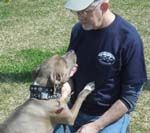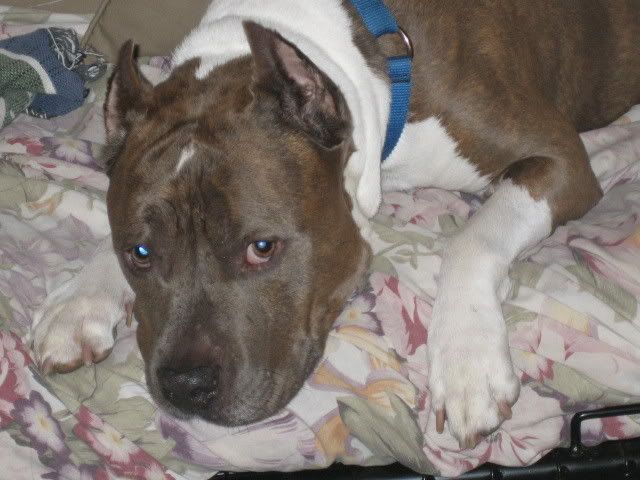|
|
Post by Dave on May 22, 2013 11:09:36 GMT -5
I took Rocky to take his ATTS test last Sunday. I should have stayed home. The test consists of meeting a stranger; the dog meeting a stranger response to unknown noise (bucket of rocks); response to sudden noise (gunshots); response to a sudden visual stimulus (umbrella opening); walking over unknown surfaces (plastic sheet and then wire grate); response to crazy stranger. WE waited about two hours with Maryellen and Sadie, and made a new friend in Courtney and Goose. When it came our turn to test, Rocky was relaxed and I thought it would be a cakewalk. We were briefed first by the test referee, then made our way along the course where Rocky had no trouble with the first two greetings. When we came to the bucket o' rocks, he startled slightly at the noise, but approached the pail and look inside. Then he noticed the lady behind the screen, who wasn't moving. That scared him... he took a pre-flight pose, but sniffed towards the woman a little, trying to determine what she was, then "huffed" and turned away. I could see that he was stressed; his hackles were slightly raised. On to the gunshot portion, where he didn't mind the noise at all. I thought everything was going well, although not as well as I expected. The umbrella test was next. We had practiced this several times in the week before, and there was no problem. As we approached the station, the umbrella opened and Rocky's flight response was, shall we say, incredible. He was out to the end of his leash immediately, growling and crying, and he wouldn't come to me. I knew the test was over then, so I tried to talk him down. The ref told me she was sorry, but that she had to excuse us from the test. Of course I understood, but Rocky didn't and as we passed the ref, he looked at her and growled. He meant it.  I felt terrible. I didn't care about the test at all, really. I put Rocky in a position that he didn't understand, couldn't handle, became frightened and severely stressed. We were watching at the edge of the field when the next tester went in, and he became fearful and defensive even then. I had to move him across the parking lot so he wouldn't feel threatened! Rocky recovered by the time we got home, but it took me a while to feel better about myself. I felt like I really let him down. So, the moral is If you want to take a test, study hard! and get someone else to take it for you.  |
|
|
|
Post by RealPitBull on May 22, 2013 11:25:45 GMT -5
Aw Dave. You didn't intentionally mean to frighten Rocky. This could have happened to anyone, you just never know sometimes how the dogs are going to respond. For whatever reason, that umbrella was just too much for him (lots of dogs cannot handle it) - it sucks that he got so upset, but it's no one's fault and it is over and done with so no need feeling guilty in any way. This stuff happens. Give him a few extra hugs and scritches and extra yummy treats.  |
|
|
|
Post by catstina on May 22, 2013 11:31:59 GMT -5
The umbrella and the metal grate are where the most dogs fail. For whatever reason, those are the super freakiest things. I'm sorry Rocky didn't pass, but it's not your fault. Give him a big hug from me!
|
|
|
|
Post by Dave on May 22, 2013 11:46:54 GMT -5
Thanks you two. He did impress several people, and Courtney just about fell in love with him. His handicap kind of draws people towards him. Rocky forgot about it all by the time we got home. I still might do the CGC with him, I don't know.
I certainly would not put Sedona through that. It was bad enough I forced her to take the hikes. After the first one I seriously considered not doing any more. She still is very uncertain about strangers, and I know how she'll take the gunshots. If nothing else the crazy stranger would make her empty her bladder on the spot.
Lola might do well. She is calm, not easily flustered. But I doubt I'll ever test her.
|
|
|
|
Post by RealPitBull on May 22, 2013 11:49:37 GMT -5
I absolutely think you should take Rocky through the CGC.
|
|
|
|
Post by catstina on May 22, 2013 12:08:49 GMT -5
CGC has some scary noises in it. In ours it was a bag filled with cans being dropped on the ground all around us. Luckily, you are allowed to comfort them in that test.
|
|
|
|
Post by Dave on May 22, 2013 12:39:42 GMT -5
Yeah, cat, I remember the test when we did it years ago. It's not that easy, either. Mary, Rocky's problem is moving objects. They startle him and trigger an immediate flight response. Plus, he's been showing some separation anxiety lately, and I think he would fail the separation test. I wanted to do something fun with him, I guess we'll just keep it to hiking and lap dancing. Lol!
|
|
|
|
Post by RealPitBull on May 22, 2013 12:55:19 GMT -5
LOL @ lap dancing
|
|
|
|
Post by michele5611 on May 22, 2013 13:34:18 GMT -5
Sorry Dave. As usual our dogs recover from something "traumatic" faster then we do! Don't beat yourself up over it.
For what it is worth I am still a proud member of the Rocky fan club!
|
|
|
|
Post by Dave on May 22, 2013 14:05:44 GMT -5
Michele, that's a pretty big club!
|
|
|
|
Post by maryellen on May 22, 2013 17:01:14 GMT -5
definitely do the cgc with him..
the one tt woman told you he had a great temperment remember? so dont forget it.. just because some dogs fail the TT test honestly doesnt mean squat... hell rufus would fail it with flying colors now if i took him for it.
|
|
|
|
Post by melonie on May 22, 2013 18:49:27 GMT -5
It seems like that test is a lot of extremes wrapped up all at once. If your dogs lead a pretty quiet sheltered life like mine... it might be hard for them to get through.
You're a good pit bull dad Dave, so don't let this get to you!
|
|
|
|
Post by maryellen on May 22, 2013 18:53:43 GMT -5
here is the actual test:
Description of the Temperament Test
The ATTS Temperament Test focuses on and measures different aspects of temperament such as stability, shyness, aggressiveness, and friendliness as well as the dog’s instinct for protectiveness towards its handler and/or self-preservation in the face of a threat.
The test simulates a casual walk through a park or neighborhood where everyday life situations are encountered. During this walk, the dog experiences visual, auditory and tactile stimuli. Neutral, friendly and threatening situations are encountered, calling into play the dog’s ability to distinguish between non-threatening situations and those calling for watchful and protective reactions.
Dogs must be at least 18 months old to enter this test. The test takes about eight to 12 minutes to complete. The dog is on a loose six-foot (6?) lead. The handler is not allowed to talk to the dog, give commands, or give corrections.
Failure on any part of the test is recognized when a dog shows:
Unprovoked aggression
Panic without recovery
Strong avoidance
The ATTS Temperament Test consists of ten subtests divided into five subcategories:
Behavior Toward Strangers
Objective: To measure the dog’s reaction to strangers in a non-threatening situation.
Subtest 1: Neutral stranger
A stranger to the dog approaches the handler, shakes hands with the handler and engages the handler in a brief conversation, ignoring the dog.
The purpose of this subtest is to evaluate the dog’s reaction to passive socialization and the dog’s protective instinct.
Subtest 2: Friendly stranger
A stranger to the dog approaches happily and briskly, is very friendly to the dog and pets the dog.
The purpose of this subtest is to evaluate the dog’s active social skills.
Reaction to Auditory Stimuli
Objective: To measure the dog’s reaction to auditory stimuli and the dog’s investigative behavior.
Subtest 3: Hidden Noise
The handler/dog team approaches a hidden assistant who rattles a metal bucket filled with rocks and sets this bucket in the path of the team. The handler may encourage the dog to investigate the bucket only when asked to do so. The handler’s focus must be on the bucket, not on the dog.
The purpose of this subtest is to test alertness and curiosity.
Subtest 4: Gunshots
The handler stops at a designated marker with his/her back towards a well hidden assistant. The assistant fires three shots using a .22 caliber starter pistol (SHOT-PAUSE-SHOT-SHOT).
The purpose of this subtest is to measure the dog’s recovery response to a sudden noise.
Reaction to Visual Stimulus
Objective: To measure the dog’s reaction to a sudden visual stimulus.
Subtest 5: Umbrella
The handler/dog team approaches an assistant sitting in a chair holding a closed umbrella parallel to the ground at a 90 degree angle to the approaching team. When the dog is five feet from the assistant, the umbrella is opened. The handler may encourage the dog to investigate the umbrella only when asked to do so. The handler’s focus must be on the umbrella, not on the dog.
Tactile Stimuli
Objective: To measure the dog’s reaction to unusual footing.
Subtest 6: Plastic Footing
Both the handler and the dog walk the entire length of a 15-foot by 6-foot clear plastic strip.
Subtest 7: Wire Footing
Only the dog will walk the entire length of a 12-foot by 3-foot unfolded exercise pen.
The purpose of these subtests is to measure the dog’s sensitivity to unusual footing, its ability to recover from the fear of unusual footing and to measure its investigative behavior to the unusual footing.
Self Protective/Aggressive Behavior
Objective: These tests collectively evaluate the dog’s capacity to recognize an unusual situation, its threshold to provocation, its protective instincts, and its propensity to realize when the situation becomes a threat.
Subtest 8: Non-Threatening
The handler/dog team stops at the designated marker. A weirdly-dressed stranger crosses the path 38 feet in front of the team.
The purpose of this subtest is to test the dog’s alertness to an unusual situation.
Subtest 9: Threatening
The weird stranger advances 10 feet towards the stationary handler in a threatening manner.
The purpose of this subtest is to evaluate the dog’s ability to recognize when an unusual situation turns into a provocation.
Subtest 10: Aggression
The weird stranger advances to within 18 feet of the stationary handler in an aggressive manner.
The purpose of this subtest is to evaluate the dog’s protective instincts.
The stranger is never closer than 10 feet from the dog. The handler’s 2 foot arm and the 6? lead is added in for a total of 18 feet. Aggression here is checked against the breed standard and the dog’s training. A schutzhund trained dog lunging at the stranger is allowed, but if an untrained Siberian husky does the same, it may fail.
At the conclusion of the test, the handler will receive a critique about the dog’s performance. Certificate will be mailed within 90 days of the test.
This copyrighted test (registration no. TXu000563600 / 1993-04-19) may not be used in whole or part without the express written consent of the American Temperament Test Society.
|
|
|
|
Post by happypuppy on Jun 5, 2013 12:24:00 GMT -5
That's disappointing and I'm sure surprising to some degree... I'm scheduled to take the test in August and have been concerned about failing for the breed's sake but an experienced friend is confident Ruby will be a "5" score dog across the board. We've been practicing the umbrella (perhaps too much, as the last time I did it I either freaked her out or she wanted to chew on it) tho she has no probs walking on any surface and runs toward all loud noises (except fireworks and vacuum cleaners). I'm still a bit nervous tho but for no real reason yet that I can see rationally. However, this morning, hubby and I both noticed that Ruby very slightly resisted getting some pets from a slightly weird neighborhood lady whom we encountered on our walk this morning - we've only just seen her a few times but never really 'met' her - perhaps I should be practicing on that altho at the vet yesterday, Ruby was pining for every person there to love on her....?!?
Dave - do practice some and go for the CGC - that's nice to have and feels good to get it if it is in the cards.
|
|












